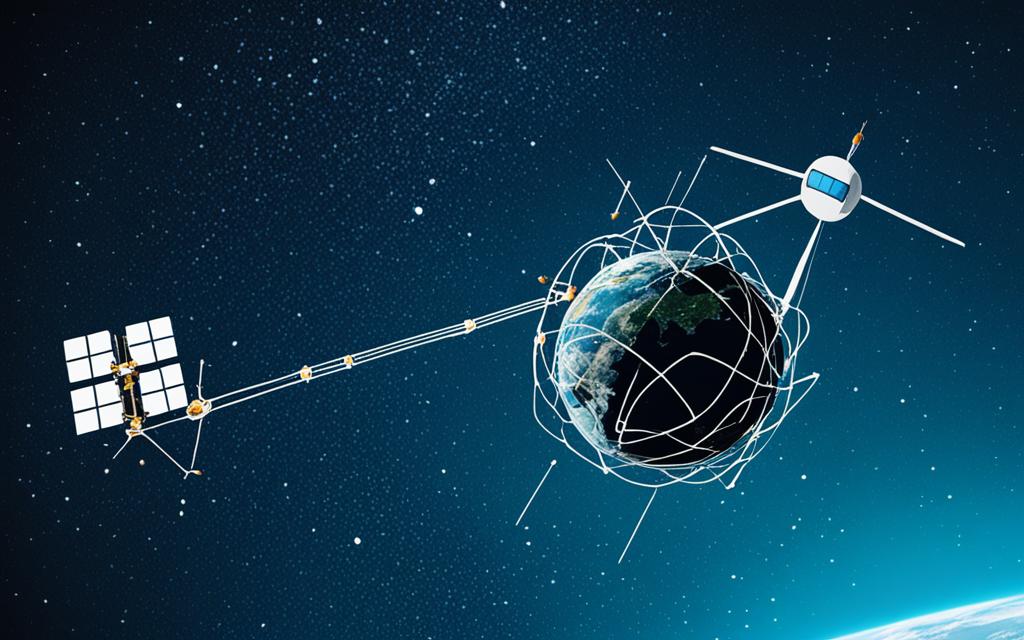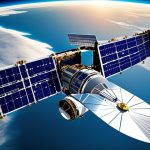In today’s digital age, connectivity plays a crucial role in empowering individuals and societies. However, the digital divide persists, leaving remote and underserved areas without access to high-speed internet. To address this challenge, the implementation of 5G NR over Satellite offers a game-changing solution.
Satellite-based gigabit service, a key component of 5G NR over Satellite, has the potential to bridge the digital divide and provide affordable connectivity to even the most remote regions. With satellite technology, areas without fiber or microwave connectivity can now enjoy seamless access to the internet, empowering communities and fostering economic growth.
Moreover, 5G NR over Satellite plays a vital role in enabling 5G mobile backhaul in areas where traditional terrestrial networks are unavailable. Through strategic partnerships like the one between Indian operator Reliance Jio Infocomm and SES, satellite-based connectivity solutions such as JioSpaceFiber are revolutionizing communication infrastructure.
By leveraging the capabilities of 5G NR over Satellite, operators can extend their networks efficiently, provide expanded coverage, and pave the way for future technological advancements. This integration of terrestrial and space-based networks strengthens connectivity on a global scale, transforming industries and benefiting billions of users worldwide.
The Growing Potential of Non-Terrestrial Networks (NTNs)
Non-Terrestrial Networks (NTNs) are poised for rapid growth with the introduction of Low Earth Orbit (LEO) satellite systems. These satellite networks are revolutionizing connectivity by offering lower-latency broadband services. Unlike traditional Geostationary Earth Orbit (GEO) satellites, LEO satellites orbit much closer to the Earth’s surface, resulting in faster data transmission and reduced latency.
The increasing demand for high-speed internet connectivity, especially in underserved and remote areas, has prompted significant investment in LEO infrastructure. Companies like SpaceX and Amazon are at the forefront of LEO infrastructure investment, with ambitious plans to deploy satellite constellations that will provide global coverage.
The investment in LEO infrastructure by companies like SpaceX and Amazon is driving the growth of satellite-based networks.
The advantages of LEO satellites extend beyond improved latency. These satellites can support a wide range of applications including broadband internet access, remote sensing, Earth observation, and disaster management. The lower altitude of LEO satellites also enables more efficient use of the spectrum, allowing for increased capacity and faster data rates.
As LEO infrastructure investment continues to grow, the potential of non-terrestrial networks becomes increasingly apparent. The combination of LEO satellites, advances in satellite technology, and the growing demand for global connectivity presents exciting opportunities for businesses, governments, and individuals alike.
Benefits of Non-Terrestrial Networks (NTNs)
The benefits offered by non-terrestrial networks are extensive:
- Expanded coverage: LEO satellites provide coverage to underserved areas, bridging the digital divide and bringing connectivity to remote regions.
- Improved latency: The proximity of LEO satellites to Earth’s surface significantly reduces latency, enabling real-time applications and enhancing user experience.
- Increased capacity: LEO satellite constellations can offer high-capacity connections, supporting bandwidth-intensive applications and accommodating a growing number of connected devices.
- Redundancy: Satellite-based networks provide a backup option for terrestrial networks, ensuring continuous connectivity even in the event of outages or disasters.
The growing potential of NTNs offers a new frontier for telecommunications, enabling innovative solutions and fostering global connectivity. As LEO infrastructure investment continues to increase, the future of non-terrestrial networks looks promising, revolutionizing the way we connect and communicate.
The Advantages and Applications of 5G NR over Satellite
5G NR over Satellite offers expanded coverage and connectivity, making it a valuable solution for various scenarios. Whether it’s providing connectivity in remote regions or supporting communication in disaster-stricken areas, satellite-based 5G NR ensures that even the most isolated locations can stay connected.
One of the key advantages of 5G NR over Satellite is its ability to enable the deployment of IoT devices. With the exponential growth of interconnected devices, satellite connectivity plays a crucial role in ensuring that these devices can seamlessly communicate with each other and the internet. From smart agriculture to remote asset monitoring, satellite-based 5G NR unlocks new possibilities for IoT implementation.
In addition, 5G NR over Satellite also contributes to the development of smart cities. By providing reliable and high-speed connectivity, satellite networks enable the implementation of smart city solutions such as autonomous transportation, energy management systems, and advanced public safety applications. This connectivity infrastructure lays the foundation for a future where cities are connected in real-time, enhancing efficiency and improving the lives of residents.
Furthermore, satellite networks offer an essential level of redundancy for terrestrial networks. In the face of natural disasters or network outages, satellite-based connectivity provides a backup solution to ensure continuous communication. By leveraging satellite networks, organizations can maintain essential operations and emergency services even when terrestrial networks are disrupted.
“With 5G NR over Satellite, we can bridge the digital divide and ensure connectivity for underserved areas, opening up new possibilities for communication and development.” – [Insert Name], CEO of [Insert Company]
Applications of 5G NR over Satellite:
- Connectivity in remote regions
- Communication in disaster-stricken areas
- Deployment of IoT devices
- Development of smart cities
- Redundancy for terrestrial networks
Challenges and Future Enhancements of 5G NR over Satellite
Implementing 5G NR over Satellite presents unique challenges that need to be addressed for seamless connectivity and optimal performance. These challenges primarily revolve around latency, coordinating networks, and spectrum allocation.
Latency and Performance Challenges
One of the significant challenges faced by 5G NR over Satellite is latency. The distance between Earth and the satellite can introduce delays in signal transmission, leading to increased latency. These latency issues can impact real-time applications such as video streaming, teleconferencing, and online gaming, where low latency is crucial for a seamless user experience.
Efforts are being made to mitigate latency challenges through technological advancements, such as reducing the distance between the satellite and the Earth’s surface. Low Earth Orbit (LEO) satellite systems, which are closer to the Earth, offer lower latency compared to Geostationary Earth Orbit (GEO) satellites. By utilizing LEO infrastructure, the latency issues can be minimized, ensuring improved performance and responsiveness.
Coordinating Networks and Ensuring Seamless Connectivity
Coordinating between terrestrial and non-terrestrial networks is another critical challenge for 5G NR over Satellite. It requires robust infrastructure and efficient network management systems to ensure seamless connectivity across both networks. The integration of satellite and terrestrial networks involves intricate coordination to establish seamless handovers, prioritization, and optimal routing for reliable and uninterrupted connectivity.
In addition to technical coordination, regulatory frameworks play a significant role in achieving seamless connectivity. Spectrum allocation policies need to be harmonized to ensure that satellite and terrestrial networks operate efficiently without causing interference. Clear guidelines and protocols should be established to facilitate efficient utilization of available spectrum resources.
Spectrum Allocation and Future Enhancements
Spectrum allocation is a crucial aspect of 5G NR over Satellite. The optimal allocation of radio frequencies determines the capacity and performance of the satellite-based networks. Effective spectrum management strategies are essential to meet the growing demand for connectivity while minimizing interference and maximizing efficiency.
In the future, enhancements in spectrum allocation techniques will be crucial to accommodate the increasing data traffic and demands of 5G NR over Satellite. Dynamic spectrum sharing and advanced spectrum management technologies will play a vital role in optimizing spectrum utilization and improving network performance.
| Challenges | Key Considerations |
|---|---|
| Latency | – Utilize LEO satellite systems to reduce latency – Develop real-time optimization techniques |
| Coordinating Networks | – Robust infrastructure for seamless handovers – Efficient network management systems |
| Spectrum Allocation | – Harmonize spectrum allocation policies – Implement dynamic spectrum sharing – Optimize spectrum management technologies |
Addressing these challenges and making future enhancements in latency reduction, network coordination, and spectrum allocation will pave the way for the widespread adoption and success of 5G NR over Satellite. Continued advancements in technology, infrastructure, and regulatory frameworks are necessary to fully harness the potential of satellite-based connectivity in bridging the digital divide and extending coverage to remote areas.

The Competitive Landscape and Commercial Models of 5G NR over Satellite
Satellite providers are actively engaging in wholesale partnerships with terrestrial operators to expand connectivity in rural and remote areas. By collaborating in this manner, they aim to bridge the digital divide and bring internet connectivity to underserved regions.
While many satellite providers view non-terrestrial networks (NTNs) as complementary to terrestrial networks, there are some who perceive them as potential competitors to traditional consumer broadband and mobile services. One such example is Elon Musk’s Starlink, which envisions satellite connectivity as a viable alternative to conventional internet access options.
| Company | Partnerships | Approach |
|---|---|---|
| Reliance Jio Infocomm | Partnered with SES | Wholesale basis for affordable satellite-based connectivity |
| Starlink | Planning global coverage | Direct-to-consumer model |
| OneWeb | Collaborating with ISPs and telcos | Wholesale and commercial partnerships |
The market for 5G NR over Satellite is experiencing rapid innovation and evolution. In response to changing demands and advancements in technology, companies are adapting their commercial models and investing in research and development to stay competitive. As the industry continues to grow, it’s crucial for organizations to remain agile and embrace innovative approaches to meet the connectivity needs of diverse populations.
Conclusion
The implementation of 5G NR over Satellite is revolutionizing connectivity by seamlessly integrating terrestrial and space-based networks. This integration bridges the gap between communication technologies, providing a holistic approach to connectivity that overcomes geographical limitations.
With the growth of non-terrestrial networks, such as Low Earth Orbit (LEO) satellite systems, coverage is expanded, enabling connectivity even in the most remote regions. Additionally, advancements in satellite technology have enhanced the capabilities of IoT devices and paved the way for the development of smart cities.
Furthermore, 5G NR over Satellite offers redundancy for critical communications, ensuring continuous connectivity even in the event of network outages or natural disasters. This capability is essential for maintaining a reliable and secure communication infrastructure in today’s interconnected world.
As the market continues to evolve, companies must adapt and innovate to fully harness the potential of 5G NR over Satellite. Collaboration between satellite providers and terrestrial operators, along with the development of wholesale partnerships, is key to extending connectivity to underserved areas. Simultaneously, regulatory frameworks and spectrum allocation will play essential roles in shaping the future of satellite-based networks.
FAQ
What is 5G NR over Satellite?
5G NR over Satellite is a technology that integrates 5G New Radio (NR) with satellite networks, providing expanded coverage and connectivity in remote regions and disaster-stricken areas. It enables the deployment of IoT devices, the development of smart cities, and offers redundancy for terrestrial networks.
How does 5G NR over Satellite bridge the digital divide?
5G NR over Satellite provides affordable satellite-based gigabit service through partnerships between satellite providers and terrestrial operators. This technology extends connectivity to rural and remote areas, bridging the digital divide and ensuring that even those without traditional fiber or microwave connectivity have access to high-speed broadband.
What are the advantages of Non-Terrestrial Networks (NTNs)?
NTNs, such as Low Earth Orbit (LEO) satellites, offer lower latency broadband connectivity compared to traditional Geostationary Earth Orbit (GEO) satellites. LEO infrastructure investment by companies like SpaceX and Amazon is driving the growth of satellite-based networks, making NTNs more viable and efficient.
How does 5G NR over Satellite enable IoT and smart cities?
With its expanded coverage and connectivity, 5G NR over Satellite facilitates the deployment of IoT devices and the development of smart cities. It allows for seamless integration between terrestrial and satellite networks, enabling efficient data transfer and communication for various smart city applications, such as traffic management, energy optimization, and public safety systems.
What are the challenges for 5G NR over Satellite?
5G NR over Satellite faces challenges such as latency and performance issues. Coordinating between terrestrial and non-terrestrial networks and ensuring seamless connectivity require robust infrastructure and efficient network management systems. Additionally, spectrum allocation and regulatory frameworks play a crucial role in driving future enhancements and optimizing 5G NR over Satellite.
How do satellite providers and terrestrial operators collaborate?
Satellite providers and terrestrial operators often form wholesale partnerships to extend connectivity to rural and remote areas. While most satellite providers see NTNs as a complement to terrestrial networks, some, like Elon Musk’s Starlink, consider satellite connectivity as a potential competitor to consumer broadband and mobile services. The market is rapidly evolving, and companies are innovating to adapt to the changing landscape.
What is the role of 5G NR over Satellite in integrating terrestrial and space networks?
The implementation of 5G NR over Satellite revolutionizes connectivity by seamlessly integrating terrestrial and space-based networks. It harnesses the growing potential of non-terrestrial networks, offers expanded coverage, enables IoT capabilities, and provides redundancy for critical communications. As the market continues to evolve, companies must adapt and innovate to fully utilize the benefits of 5G NR over Satellite.



















